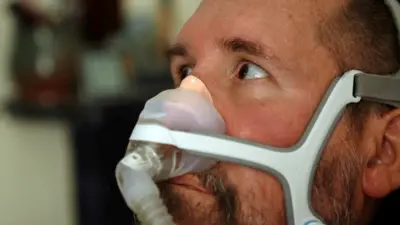We've updated our Privacy and Cookies Policy
We've made some important changes to our Privacy and Cookies Policy and we want you to know what this means for you and your data.
Slides and clothes grow as children get fatter
Top Stories
- Author, Tamsin Smith
- Role, ǵüµÇ¨û§ Breakfast reporter
The comparison between the faded blue plastic slide and the new shiny green one was striking.
Its hard to ignore the increasing size of the nation's children when you see a slide from 25 years ago next to its present day counterpart.
We are not talking a couple of centimetres to allow for changing fashion and bulging pockets, but a 50% increase in the width of the bit that bottoms slide down.
"Of course we're not saying that children's bottoms have got 50% bigger," smiles Chris Martyn-Smith, Managing Director of TP Activity Toys.
They have been making children's play equipment for the past half century and have been adapting their designs as children's shapes have changed.
Top Stories
"The children that we are designing for are predominantly between the age of 2 and 8 and those children now are bigger than they were before - and that's very much reflected in a product like our swing seats or our slides," he says.
Sophisticated computer programmes are used to test the weight that toys can withstand.
"Its very important for us to know how children are growing and getting bigger, it has a massive impact on our design and manufacture," he says.
Top Stories
Many retailers are still working with measurements of children collated in the 1990s before the obesity epidemic really gathered pace.
The Child Measurement Programme, which measures the height and weight of school children in England and Wales, is used as a more up to date reference point.
But retailers and manufacturers are eagerly awaiting the results of the National Childrenswear survey.
Commissioned by four major high street retailers - Next, Monsoon, George at Asda and Shop Direct - Shape GB is the first large-scale project to measure children aged 4-17 across the country using 3D body scanners.
The results are due out mid-2011, but the ǵüµÇ¨û§ has been given an exclusive glimpse of how it is analysing the differences in height and body shape between children of different ages.
"I think it's fair to say children are getting bigger," says Richard Barnes from Select Research, "but it's not just in terms of weight around the stomach, it's also in terms of height.
"We're not sure whether its upwards, or sideways or both. And that's why this data is so comprehensive," he adds.
Growing waistlines
Statistics already indicate that children are getting fatter.
Since the 1970s, children's waistlines have expanded by an average of 12.5cm, according to the Child Growth Foundation.
The number of obese children has risen by one third in the past decade.
And with more than 30% of children now classed as overweight, this already affects product design
At TP toys, a new clothing range is being launched with bigger children in mind.
There are elasticated waists and cuffs, and buttons on the legs.
Marks and Spencers has already made headlines with its launch of plus size school uniforms.
But if the new research confirms that the nation's children are getting wider, should retailers give commercial recognition to this?
At a workshop run by the MEND programme to help overweight children and their parents, there are mixed opinions.
"Buying clothes for Olivia is difficult," says mum Vicky Cumberland, "she's taller than the others in her class".
"And fatter," Olivia interrupts.
Although aged seven, she wears clothes for a 12 to 13 year old and thinks it would be nice to buy things without sizes on.
"But we shouldn't take it for granted that clothes can keep getting bigger and bigger," warns Vicky, "because parents will think it's acceptable for children to keep growing".
No-one knows how retailers and manufacturers will use the new 3D childrenswear survey when it is released.
It will certainly provide the most sophisticated set of data about children's bodyshapes today.
But with plus size ranges for larger children already on sale, commercial recognition of bigger sizes may become the norm.
Top Stories
More to explore
Most read
Content is not available








